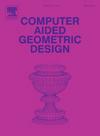基于欧拉弹性和曲率的非线性网格去噪方法
IF 1.7
4区 计算机科学
Q3 COMPUTER SCIENCE, SOFTWARE ENGINEERING
引用次数: 0
摘要
在本文中,我们推广了一个新的非线性变分模型,该模型是基于一般欧拉弹性和曲率的三角曲面。该模型将梯度算子和曲率算子以乘法的方式结合在一起。通过引入限制于三角形的总变分范数,将三角曲面上的欧拉弹性模型和曲率模型分别离散为基于三角形和基于边的公式。提出了一种基于通用欧拉弹性和曲率模型的两阶段网格去噪方法:首先基于欧拉弹性和曲率模型对面法线进行滤波,然后更新顶点位置。通过一种有效的松弛,基于算子分裂和乘法器交替方向法(ADMM)迭代求解非线性不可微优化问题。从参数敏感性、与几种最新技术的定量比较和计算成本等方面对所提出的去噪方法进行了评估。数值实验证实,与现有的几种降噪算法相比,我们的方法在合理的成本下产生了具有竞争力的结果。它通过保留更清晰的特征,恢复更多的细节和结构,减轻楼梯效应(假边缘),取得了令人满意的效果。定量误差进一步验证了算法的数值鲁棒性。本文章由计算机程序翻译,如有差异,请以英文原文为准。
Euler's elastica and curvature based nonlinear mesh denoising method
In the paper, we extend a new nonlinear variational model based on the general Euler's elastica and curvature for triangulated surfaces. The new model intrinsically combines the gradient operator and the curvature operator in a multiplicative manner. By introducing the total variation norm restricted to triangles, we discretize the Euler's elastica and curvature model on triangulated surface into the triangle-based and edge-based formulations, respectively. A two-stage mesh denoising method is proposed using the general Euler's elastica and curvature model: first filtering the facet normals based on the Euler's elastica and curvature model and then updating the vertex positions. Through an efficient relaxation, the nonlinear and non-differentiable optimization problem is solved iteratively based on the operator splitting and alternating direction method of multipliers (ADMM). The proposed denoising method is evaluated in terms of parameters sensitivity, quantitative comparisons with several state-of-the-art techniques, and computational costs. Numerical experiments confirm that our approach produces competitive results when compared to several existing denoising algorithms at reasonable costs. It achieves promising results by preserving sharper features, restoring more details and structures, and alleviating the staircase effect (false edges). Moreover, the quantitative errors further verify that the proposed algorithm is robust numerically.
求助全文
通过发布文献求助,成功后即可免费获取论文全文。
去求助
来源期刊

Computer Aided Geometric Design
工程技术-计算机:软件工程
CiteScore
3.50
自引率
13.30%
发文量
57
审稿时长
60 days
期刊介绍:
The journal Computer Aided Geometric Design is for researchers, scholars, and software developers dealing with mathematical and computational methods for the description of geometric objects as they arise in areas ranging from CAD/CAM to robotics and scientific visualization. The journal publishes original research papers, survey papers and with quick editorial decisions short communications of at most 3 pages. The primary objects of interest are curves, surfaces, and volumes such as splines (NURBS), meshes, subdivision surfaces as well as algorithms to generate, analyze, and manipulate them. This journal will report on new developments in CAGD and its applications, including but not restricted to the following:
-Mathematical and Geometric Foundations-
Curve, Surface, and Volume generation-
CAGD applications in Numerical Analysis, Computational Geometry, Computer Graphics, or Computer Vision-
Industrial, medical, and scientific applications.
The aim is to collect and disseminate information on computer aided design in one journal. To provide the user community with methods and algorithms for representing curves and surfaces. To illustrate computer aided geometric design by means of interesting applications. To combine curve and surface methods with computer graphics. To explain scientific phenomena by means of computer graphics. To concentrate on the interaction between theory and application. To expose unsolved problems of the practice. To develop new methods in computer aided geometry.
 求助内容:
求助内容: 应助结果提醒方式:
应助结果提醒方式:


